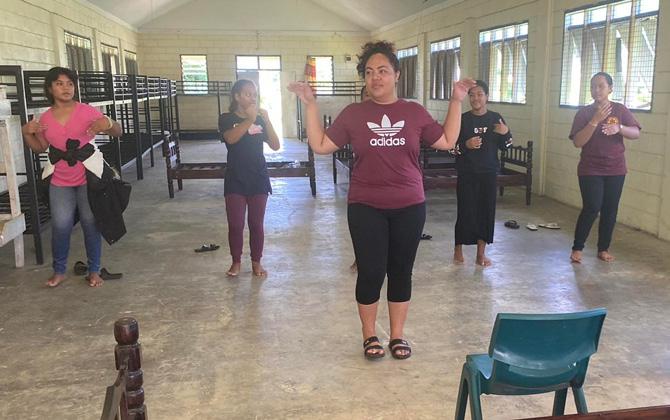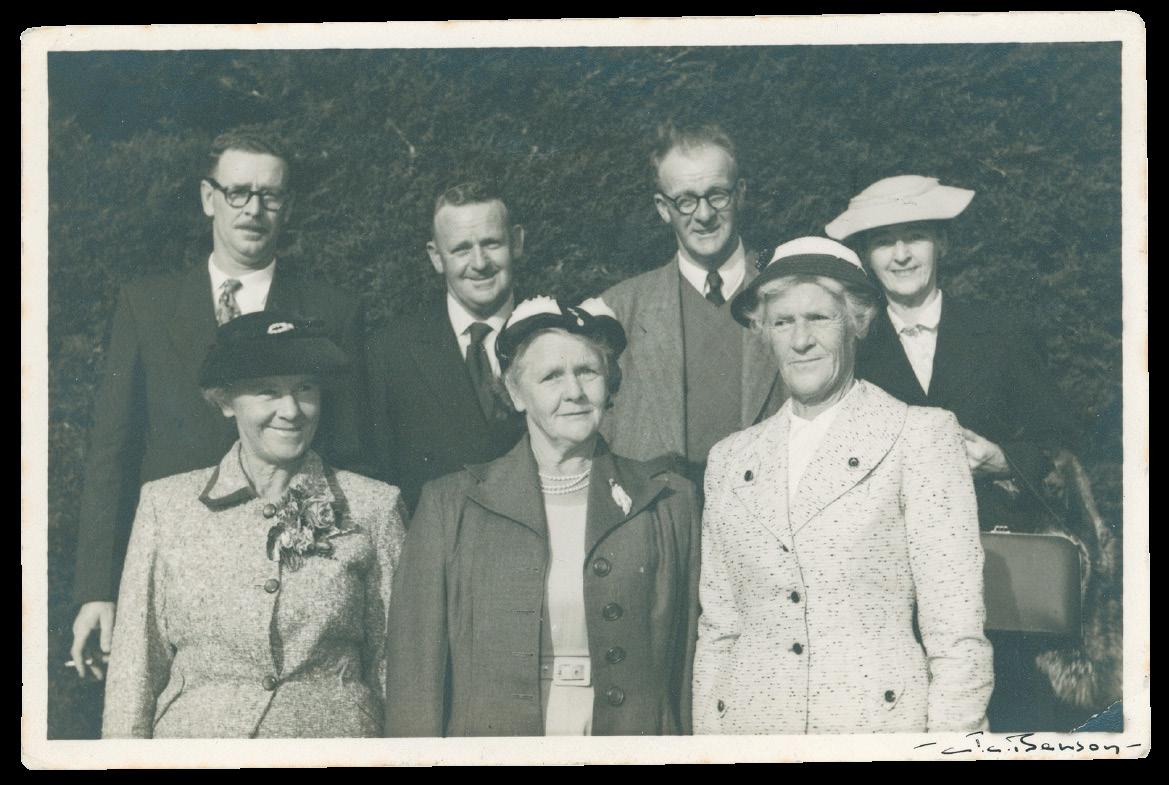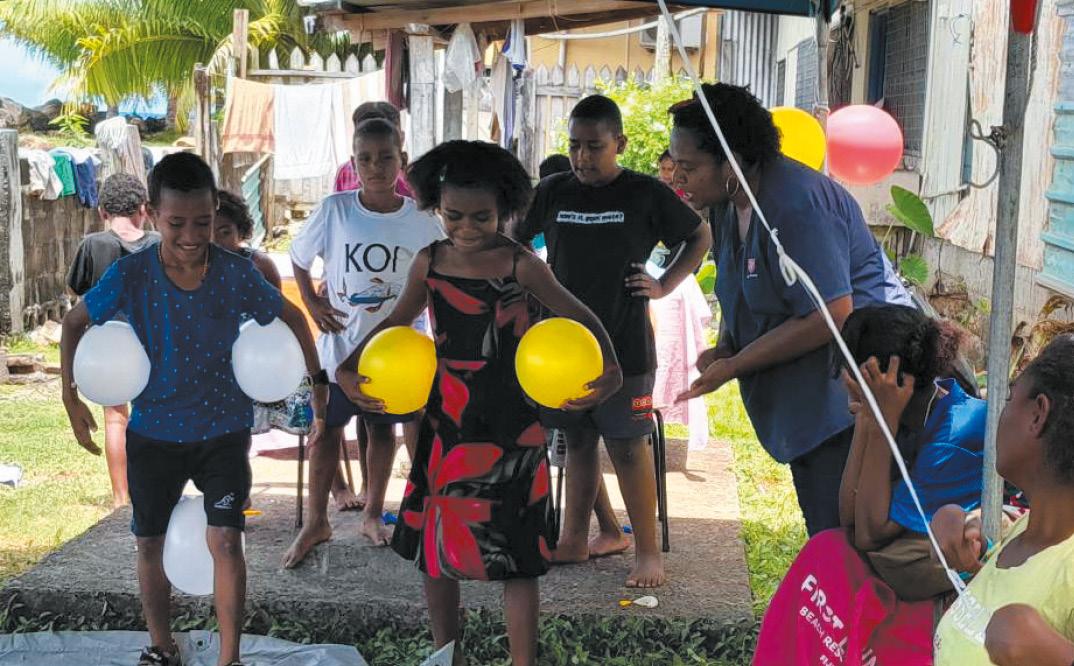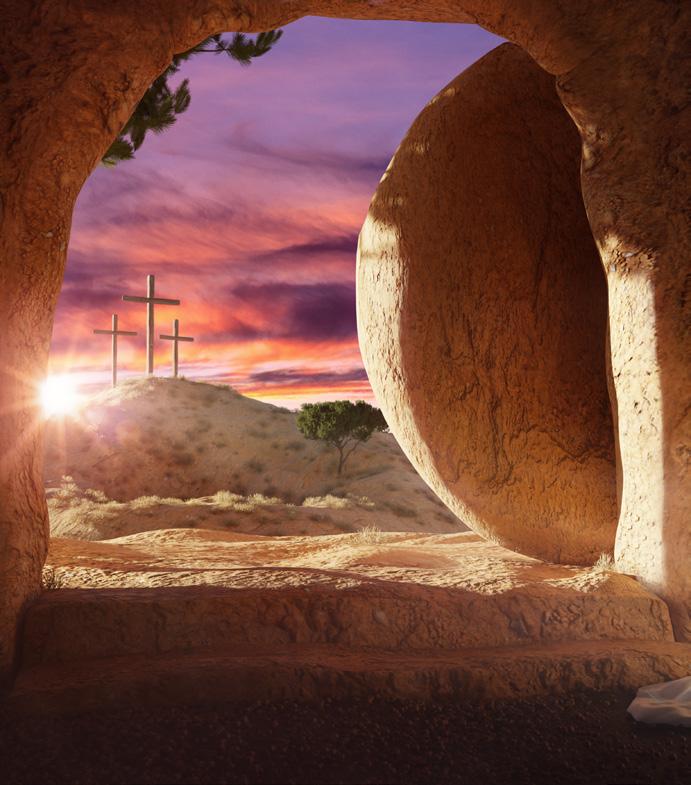
by Grace April 2023 | warcrymagazine.org.nz Fix Your Eyes on Jesus The General's Easter Message From Death to Life Family Legacy of Faith war cry
Transformed
8 General's Easter Message

‘It is finishied’ (John 19:30), a reflection on the completion of Christ’s mission of redemption.


14 Family Legacy of Faith
Stella Derham from Linwood Corps shares the stability of family and faith in her life.
18 Movers and Makers
Amplify Creative Arts Camp in Tonga and Samoa Regions showcases the talents of their young people.


20 Celebrating 140 Years in New Zealand
Punching above our weight since 1883, The Salvation Army remains hard at work serving our communities.
28 Response to Cyclone Gabrielle
Walking together to bring relief in the hardest hit areas of Gisborne, Napier and Hastings.

War Cry Magazine
The Salvation Army New Zealand, Fiji, Tonga and Samoa Territory
Territorial Leaders
Commissioners Julie and Mark Campbell
General
Brian Peddle
Founders
Catherine and William Booth
Editor Vivienne Hill
Graphic design Sam Coates, Nicole Gesmundo, Lauren Millington
Staff writers
Jules Badger, Hope Burmeister, Captain Rachel Montgomery, David Youngmeyer
Proof reading Colleen Marshall
Connect with us warcrymagazine.org.nz
SalvationArmyNZFTS @SalvationArmyNZ salvationarmynzfts
Territorial Headquarters, 204 Cuba Street, PO Box 6015, Marion Square, Wellington 6141 p: (04) 384 5649
e: warcry@salvationarmy.org.nz
Subscriptions mailorder@salvationarmy.org.nz
Print Management MakeReady

All Bible references from the Holy Bible, New International Version, unless otherwise stated.
Views and opinions expressed do not necessarily represent those of The Salvation Army.
Articles are copyrighted to The Salvation Army, except where indicated, and may be reprinted only with permission.
15 30 25 35 18 26
05
Publishing
Volume 2, Issue 6 ISSN
ISSN
for 139 years
0043-0242 (print)
2537-7442 (online)
2 April 2023
Contents
Christ Calls the Shots
hat a privilege it is to live in the four nations of our territory where we can freely celebrate Easter with a long weekend and remember the significance of this most holy Christian festival. But maybe your celebrations might be like some of my Easter weekends: just a blur of activity, chocolate and hot cross buns. Maybe the movement and transitions of Easter are not marked as distinctly as they should be, the time is not taken to slow down and intentionally sit in the significance of the events remembered. This Easter, I invite you to enter each day and contemplate the enormity of a gift freely given to humanity—the life, death and resurrection of Jesus Christ.
The biblical events leading up to what is our Easter Friday read in the gospels like the powers of darkness were in full control and calling the shots. But it soon becomes clear that Christ himself set in place the timeline of events and paced out the steps predicted hundreds of years before in the Old Testament: from riding a donkey into Jerusalem, the intersection of Passover feast, to the necessity of Christ’s suffering. For example, the Jewish leadership at the time did not want to kill Jesus
on a feast day, but they were not in control. Even the timing of Jesus’ betrayal by Judas was set in motion when Jesus announced to the disciples in the upper room that one of them would betray him.
In Major Mat Badger’s article on page 24, he highlights the fact that Jesus went to the cross of his own free will. He hung suspended between heaven and earth not held by the nails driven into his hands, but willingly staying the course and suffering in our place so that we would not have to experience the complete separation from God that Christ experienced on the cross.
This Easter, as we take the time to pause, to remember, to lament and contemplate the enormity of his sacrifice, we can only be eternally grateful that Christ made the way for us to be reconciled to our Creator.
Please note: The name of this territorial magazine is changing. Watch out for the May edition.
Vivienne Hill Editor
warcrymagazine.org.nz 3
Easter is the only time when it’s perfectly safe to put all your eggs in one basket. EVAN ESAR
Thirteen Lives
Drama
Thirteen Lives tells the true story of the rescue of the boys’ soccer team stranded in an underground cave in Northern Thailand. Though a well-known event, the movie is still captivating as it portrays how the rescue unfolded. The experience of the international cave divers and the importance and sacrifice of the Thai community is central to the story. It is also inspiring to witness the bravery and resilience of the young footballers and their assistant coach. This is a riveting movie, with such a satisfying conclusion that it seems almost too good to be true, yet we know it is.

(Reviewed by Fay Foster)
MH370: The Plane that Disappeared

Investigative documentary | Directed by Louise Malkinson | Watch on Netflix
‘Planes go up, planes go down, what planes don’t do is just vanish off the face of the earth.’ This three-part Netflix docuseries examines nearly a decade’s worth of evidence regarding Malaysian Airlines flight MH370. In a world where technology seems to track our every move, the flight remains a mystery even after intense scrutiny from experts across the planet since 8 March 2014. An easy but unsettling watch that raises more questions than it answers, particularly about the ability of political power to obscure the truth when it is inconvenient or advantageous. It’s a delicate walk, holding the tension of seeking closure for the families while exploring three theories about what could have happened. (Reviewed by Matt Gillon)
Art + Faith
Faith/Art/Culture | Makoto Fujimura | Yale University Press

This beautifully written book by renowned Japanese American artist Makoto Fujimura intersects art, faith and culture, carefully woven together to create this small masterpiece. Makoto uses the Japanese art form Kintsugi to illustrate the value of brokenness and God’s ability to line the broken seams with gold and precious material in order to recreate a broken vessel. NT Wright’s foreword says of Makoto’s work: ‘From broken teacups to broken lives and broken societies— mending is part of making, and making is part of God’s redemptive purposes’. Themes of newness in creation, Christ’s tears in the cultural river and the creative nature of God are some of the highlights. A wonderful addition to any library, this book comes highly recommended.
(Reviewed by Vivienne Hill)
 | Directed by Ron Howard | Watch on Amazon Prime
| Directed by Ron Howard | Watch on Amazon Prime
4 April 2023
Source: Please Don’t Pray With Your Mouth Full , by Bob Swanson.
In Wonder
I wonder what I would have done on that day 2000 years ago? If I had stood in the shadow of the crucified Christ, would I cry? Would I scream and yell at the authorities? Would I feel anguish and despair? Desperation?

I wonder what I would have done? Could I have sat there in the heat of the day, waiting seeing the hot sun turn to darkness pierced by the tearing sound of the curtain the ground beneath me shake, knowing the fate that this torture would bring—death.
I wonder what I would have done? Stared in amazement knowing the reason behind this torture looked upon his body pierced by a crown of thorns, nails and spear realising it was all for me? A single tear falls…
I do not wonder what he has done, I know what He has done.
Lieutenant Rae Evans
Easter Traditions Around the World Flying kites
On the British Overseas Territory of Bermuda, residents fly their colourful, homemade kites on Good Friday. The tradition started when a local Sunday school teacher used a kite to tell the story of Jesus’ ascension to heaven.
Creating colourful outdoor carpets
In Antigua Guatemala (Guatemala), they cover the streets with colourful carpets for their Good Friday procession. The carpets are made from coloured sawdust, fruits, vegetables and sand.

Eating a giant omelette
In Haux, France, every year a giant omelette is served in the town square for Easter Monday. The omelette is made of more than 4500 eggs and feeds 1000 people!
Reading crime novels
Norway is all for something different during Easter weekend—reading crime novels (known as ‘Easter crime’). The tradition started in 1923, when a crime novel was advertised on the front page of a newspaper, and some people didn’t realise it wasn’t real news.
INTERNATIONAL PRAYER
• Turkey and Syria—Continue to pray for those impacted by the earthquakes and for people seeking emergency accommodation and food relief. Pray for rebuilding in these countries.
• Somalia—Pray for protection and peace amidst violence against believers. May isolated Somalia converts know the comfort of God and continue to mature in their faith.
• Pakistan—Pray laws change so Christians are protected from persecution. May God also protect and help impacted Pakistanis to find safe accommodation after last year’s flooding.
SALVATION ARMY PRAYER
Please keep all those people and communities impacted by Cyclone Gabrielle in your prayers. We continue to pray for the Kingdom of Tonga rebuilding after the eruption and tsunami; Woodville Corps; Youth Mission Department; Addictions, Supportive Housing and Reintegration Services; Albany Bays Corps; Alexandra Corps; Aranui Corps; Ashburton Corps; Auckland City Corps; The Salvation Army in Latin America North; and The Salvation Army in Liberia and Sierra Leone.
• Mali—Pray for change of laws and stability within the Government in Mali. For Christians who have lost their jobs because of their faith, pray they will find a way to support themselves and their families.
• Algeria—Pray for opportunities for Christians to gather together and for churches to be able to safely reopen. May God keep Algerian Christians firm in their faith despite persecution.
warcrymagazine.org.nz 5
Do You Know These People?
If you recognise the people in this photo, we’d love to hear from you. Email: archives@salvationarmy.org.nz

Red Shield Appeal
Many Kiwis are living on the edge, one step away from hardship. They may be one meal away from running out of food, one more payday away from running out of money, or one more life trauma away from having serious mental health issues. This can happen to anyone at any time, as disaster can strike when we least expect it. But you can help to ease someone’s burden by donating to Red Shield Appeal this year. Donations go towards Community Ministries wraparound support, such as food relief, advocacy, counselling, social work, life skills and practical aid. For more information, visit salvationarmy.org.nz/RedShieldAppeal
The Salvation Army in New Zealand for 140 years | Dunedin City Corps
01–02 April
As the first corps in New Zealand, the celebrations will include a bus tour of historic Salvation Army sites, a prayer meeting at the Cargill monument, and a historical photographic display in Princes Street. Bus tour bookings are essential. Contact Dunedin City Corps for more information.

Easter Camps | North Island— Mystery Creek, Hamilton; South Island—Spencer Beach Holiday Park, Christchurch
06–10 April
Join other young people for a long Easter weekend of fun and fellowship, playing games, joining in small groups, worship, speakers and much more!
Auckland City Corps 140 years celebrations
07–09 April
This Easter weekend,
QUICK QUIZ
1 During Greek Orthodox Easter, what colour do they dye Easter eggs?

2 Who wrote the music for rock opera Jesus Christ Superstar?
3 Easter Island is part of which country?

4 What is the filling in Cadbury Creme Eggs made of?

5 Before and during Jesus’ death there was darkness in the land. How long did it last?
Answers page 32
Auckland City Corps are celebrating 140 years of ministry in Auckland, with ‘remembering’ on Friday, ‘celebrating’ on Saturday and ‘looking forward’ on Sunday.
BMAC: Kids Peak Adventure

17–21 April
Blue Mountain Adventure Centre camp for 8–13 year olds, with themes of developing teamwork, leadership and confidence. Activities may include white water rafting, caving, rock climbing and more!
If Easter says anything to us today, it says this: You can put truth in a grave but it won’t stay there.
CLARENCE W HALL Griggsonunsplash.com 6 April 2023
T h omas
Apple and Ginger Streusel Cake

This is a light textured cake with a lovely spicy, scrunchy layer swirled through the middle. It’s excellent with coffee or tea. Serve warm or cold. | 90 mins | Makes one 20cm ring cake
Ingredients
For the streusel:
• ⅓ cup brown sugar
• 3 Tbsp plain flour
• ¾ tsp ground ginger
• ¼ tsp cinnamon
• 30g melted butter
• ⅓ cup chopped pecans or walnuts (optional)
Method
For the cake:
• 1 apple peeled, quartered and sliced
• 125g butter
• 1 cup sugar
• 2 eggs
• 1 tsp vanilla essence
• 2 cups plain flour
• 1 tsp baking soda
• 1 tsp baking powder
• 1 cup milk, soured with a squeeze of lemon juice
Preheat the oven to 180°C. Combine the streusel ingredients and set aside. Thoroughly grease a 20cm ring tin.
Beat together butter and sugar, add eggs one at a time, beating the mixture well after each addition—the mixture should become pale and light (use a food processor or beaters if you have them). Add the vanilla.
Combine the baking soda and baking powder with the flour and fold into the butter mixture a little at a time, alternating with the soured milk to form a batter. Spread half the batter into the bottom of the greased ring tin. Sprinkle in half the streusel mixture; add the remainder of the batter then the remainder of the streusel mix. Arrange the apple slices in a circular design on top of the streusel. Press the slices in at a slight angle so they fan slightly.
Bake for around 50 minutes, until dark golden and springy. Cool slightly in the tin before removing.
Source: Sophie Grey | destitutegourmet.com
Refocus Easter
Easter can become overstuffed with chocolate eggs, bunnies, Easter egg hunts and trips away while enjoying a fourday holiday. However, taking time to reflect and meditate on the sacrifice Jesus made can help to refocus Easter back on Christ. Try attending your local corps (church) for a special Easter service or take time to read the Easter story in the Bible and write down anything that stands out in the passages. Try going for a walk and think about what parts of your life Christ has ‘resurrected’ or brought to life this year. If you want to include more people in the reflections, consider having a meal together and have each person share something God has recently done in their life.
Photography: Old Youth on unsplash.com
WORD OF THE MONTH Bula
(Fijian, exclamation) Life, good health, hello, welcome.
Source: 24hourslayover.com

warcrymagazine.org.nz 7
The General’s Easter Message 2023
‘It is finished’ (John 19:30)
This Easter comes as Salvation Army leaders from around the world have been called together to elect a new General. The privilege of serving in the role of international leaders is now coming to an end for Commissioner Rosalie and me, and we seek to complete what we had set out to do. Soon we will need to say, ‘It is finished’.
So when I reflect on Easter, I am drawn to the words of Jesus on the cross: ‘It is finished’. But how much more profound are those words on Jesus’ lips as recorded in John 19:30. His earthly life and ministry—the greatest of all human lives and the most far-reaching of all ministries— was complete.
It is finished.
But the words ‘It is finished’ take on yet deeper meaning when we consider that Jesus spoke them in his own language of Aramaic, so the word he used indicates complete submission—completed before he died. In Christ, God-who-couldnot-die voluntarily and completely submitted to becoming human. In so doing he experienced pain, suffering and death itself. Paul echoes this in Philippians 2:5–8 (NRSV) when he writes, ‘Let the same mind be in you that was in Christ Jesus, who, though he was in the form of God, did not regard equality with God as something to be exploited, but emptied himself, taking the form of a slave, being born in human likeness. And being found in human form, he humbled himself and became obedient to the point of death – even death on a cross.’ Jesus clothes himself with our humanity. He understands us.
He experienced the extremity of a public execution with all its humiliation. His identification with us in the human experience— including pain, suffering and death —stands completed.

It is finished.
When John later wrote his Gospel in Greek, he recorded ‘It is finished’ as the last words of Jesus, using a word from the world of finance meaning ‘paid in full’. So the evangelist reminds us that, in Jesus’ complete submission, he paid the debt of sin for all humanity. On the cross, our account has been paid in full. Paul connects ‘paid in full’ with no longer counting our sins and the important emphasis of reconciliation through the cross. He describes this in 2 Corinthians 5:19 (NIV): ‘God was reconciling the world to himself in Christ, not counting people’s sins against them... .’ Sin is no longer the issue—the only thing of importance is how we will respond to a Saviour who has paid the account in full.
It is finished.
At the start of the year, I affirmed the ‘once and for all God’. In Romans 6:10 we read: ‘The death he died, he died to sin once for all; but the life he lives, he lives to God.’ God’s provision for us began with a new covenant, commencing with the
cross. Once and for all. Paid in full. Hebrews 9:28 reminds us that Christ was sacrificed once to take away the sins of many, including us, while John 1:29 proclaims, ‘Behold, the Lamb of God, who takes away the sin of the world’ (ESV). That is my sin, and your sin.
It is finished.
In the truth that Christ died once and for all, there is also the truth that he lives, and because he lives, we can live also. This is the essence of the Easter message. No matter what comes, the truth of God’s action on our behalf remains rock solid. No matter what comes, we are safe in his hands and fully aware of his provision. No matter what comes, we can live as ‘more than conquerors’ and ‘overcomers in the midst of all things’, because his grace is sufficient and he is faithful. Romans 5:8 says: ‘But God demonstrates his own love for us in this: while we were still sinners, Christ died for us.’ It’s done! For once and for all time … and that changes everything.
It is finished.
Commissioner Rosalie joins me in sending you warm Easter greetings.
Brian Peddle General
8 April 2023

warcrymagazine.org.nz 9
From Death Daily to New Life Every Day
This article contains themes of death, abuse, suicide, PTSD and other trauma. While acknowledging latest research which does not endorse trigger warnings, we include this as a courtesy.
Tania Viljeon found her way to The Salvation Army and new life in Christ while living with post-traumatic stress disorder (PTSD). Today, not only is Tania full of hope for the future, but she is now a first-year cadet, passionate about sharing what God has done in and through her.
WORDS Jules Badger
hen forensic scientist Tania Viljeon found herself standing amidst the bloody aftermath of yet another violent crime scene, she realised she was done with police work. Heavily pregnant with her first child, Tania knew she no longer had the strength to compartmentalise the trauma she carried. ‘That was my moment,’ she says. ‘Walking into a place and seeing a dead child and not feeling anything—especially when you’re carrying one—that can’t be normal.’ That moment of clarity was the beginning of Tania’s long journey towards healing and a new life.
Raised in Pietermaritzburg, South Africa, Tania’s parents divorced each other twice during her childhood. ‘That in itself brought a lot of heartache,’ explains Tania, who also suffered abuse as a child at the hands of an extended family member. From a young age, Tania learnt to compartmentalise. So when she joined the police as a 20-year-old, Tania already had a well-established practice for coping with the horrors she experienced on the job.
Staring death in the face
The first time Tania came face-to-face with death was when she was working with the riot unit. ‘As part of my
“initiation” the guys thought it would be a good idea to take me to a mortuary. They chose the biggest one in Durban, and it wasn’t orderly and sterile like in the movies, the bodies were literally stacked up on top of each other in piles on the floor in these huge walk-in fridges. Body upon body—body pieces even. And there were women who had died during childbirth, with their stillborn babies piled on top of them. It was horrible.’
There was no one Tania could speak with about this traumatic experience—which was the first of many.
‘There was no debriefing in the South African Police Force in the nineties,’ Tania explains. ‘There was no after-care or supervision—nothing. I didn’t realise how damaging it all was until toward the end of my career,’ Tania explains.
Interacting with death daily continued for Tania when she qualified as a ballistics specialist. Working at crime scenes, reconstructing scenarios to chart bullet trajectories, examining firearms and attending post-mortems were all part of the job. But Tania was suffering with undiagnosed PTSD.
‘I now understand there was a lot of compartmentalising going on—that’s how I coped. I was angry and numb all the time. I was angry at things I didn’t know still
10 April 2023
bothered me, like my parents divorcing. I was just angry at everything. I was hospitalised once during that time and they tried all sorts of antidepressants, but I wouldn’t take them consistently. I didn’t think a pill could fix what was broken inside me. Therapy was suggested but I wouldn’t engage, because in my eyes I wasn’t the problem—everyone and everything else was. So, I would default to anger because that was what I knew—anger and numbness were my normal.’
A second chance at life
Migrating to New Zealand in 2007 seemed like the opportunity for a second chance at life. Tania became pregnant again after settling in Auckland, but she was still living with undiagnosed PTSD, the effects of which played a part in the end of her marriage. ‘All that anger and hardness and numbness just came with me to New Zealand.’

Tania became concerned one of her girls wasn’t coping with the separation from her dad, so a therapy session was arranged. But it was quickly determined that the person needing help was Tania. ‘The therapist could
clearly see that I wasn’t doing well, and that started a journey of about 40 sessions,’ explains Tania. ‘I wanted to get well, but it was all so confronting. And I was a solo mum which meant I came home from sessions to the girls. I had to be a mum, while trying to process my anger. It was very hard.’
Tania was formally diagnosed with PTSD, and as she did the hard work, her emotions began to surface. ‘It was like letting go of this control I had built up to protect myself. I was so used to compartmentalising— pushing things deep inside me. But therapy loosened everything up and now my emotions pour out! In a way, the diagnosis restored a sense of healthy control because now I can name why I acted and behaved and felt certain ways.’
Above: Tania with her daughters at the 2023 Territorial Welcome to Cadets at Johnsonville Corps, Wellington.
warcrymagazine.org.nz 11
‘It was a huge shock, but I know now that I am well because I recognise that I need to grieve.’
Tania began to feel something stirring within her spiritually. ‘I tried a few churches, but as a solo mum, I felt looked down upon. Then I walked into East City Salvation Army, and everyone was so welcoming that I made friends quickly.’
screeching tyres of a car pulling up outside and a woman’s terrified screams. ‘My mind immediately went into police mode, and I assumed it was a stabbing and raced towards the action. But it wasn’t a stabbing, it was a woman in advanced labour! There was no time to go inside, so God took over and we birthed her baby in the car! It was amazing! I sensed God saying, “No more death, Tania, but new life every day!”’
Tania found a ministry amongst the women, especially those whose babies had been uplifted by Oranga Tamariki. ‘It was common, and it didn’t feel right to me as a mother myself. Irrespective of their pasts— they could be drug addicts or come from prison to give birth—on the maternity ward these women were mothers first and foremost. It felt wrong for them to leave with empty arms, so I always arranged for two matching teddy bears to be knitted—one to go with the baby and the other for the mum. The idea was that one day those two teddies would be reunited, and for the mothers to have something to hold in the meantime—especially those returning to prison alone.’
Tania now had the mental space to take a spiritual deep dive. ‘Spiritually, there was a revival within me. I had been like a dead leaf, but I was coming back to life. I’d been so numb but now there was this new life in Christ.’
New life every day
God provided Tania with a job at Middlemore Hospital in the maternity ward. One morning she heard the

There were even times when Tania was able to pray with some of the mothers. ‘I wasn’t supposed to pray with them, but I did. I also took photos of them with their babies so that when they returned to prison with nothing to do but think, they would have something tangible to inspire them—someone to live for and keep going for.’
The language of prayer
A few years later a close friend from the police committed suicide. ‘I relapsed,’ says Tania. ‘This was
 From top: The work of mapping bullet trajectories in South Africa; Tania with an award for excellent performance in combat rifle shooting.
From top: The work of mapping bullet trajectories in South Africa; Tania with an award for excellent performance in combat rifle shooting.
12 April 2023
‘...when Jesus died on that cross and rose again, he gave everyone the opportunity not only for salvation—but also for a second chance—for a brandnew life!’
someone I had worked with on a lot of crime scenes. His suicide was so hard to process, and the wheels came off for me.’
One night a friend became very concerned about Tania. ‘The police came to do a welfare check,’ she explains. ‘The officer had been in the South African police. “I know what you have seen, and I want to pray with you,” he said. He prayed in my own language of Afrikaans! Later I was at the hospital and the nurse who triaged me saw my cross necklace and she also prayed for me!’
God held Tania tightly throughout it all, as did her church family. ‘I just had to be with the people who loved me and understood my journey and wouldn’t judge me,’ testifies Tania. She now puts her sustained wellness down to that love, as well as therapy, medication, and the Spiritual 12 Steps she completed at Booth College of Mission (BCM) in 2019.
‘I use the analogy of a bookshelf. Before therapy and 12 Steps, the books were all crammed in haphazardly. If you pulled a book out, all the others fell out with it. But now my books are standing up straight and in some sort of order. I can take out a book without the rest of them toppling down on me.’
A growing sense of calling from God to share her story through ministry as a Salvation Army officer began to

take root. Tania applied and was accepted for training and is currently a first-year cadet in the Champions of the Mission/Ngā Toa o te Mihana session. As Tania prepared to leave Auckland for training she spoke with her mum. ‘Mum told me to drive down safely, have fun, and that she was proud of me.’
Two days later, Tania’s mum passed away suddenly. ‘It was a huge shock, but I know now that I am well because I recognise that I need to grieve. I can take ‘Mum’ off my shelf and allow time to process her death. I have this awareness now that comes from a healthy place.’
Resurrection life
Tania has an Easter message for readers: ‘The resurrection is all about new life and second chances. And that’s the thing with me, I don’t want or need to sugar coat any of this. I don’t want to hide it and say I wasn’t very well—I was suicidal. That’s the truth. There is no way around it. But God got me through, and I want others to know there is a way forward— there are so many others out there living with tough things. I’m not suggesting my story is unique because I know there are others who can relate, if not with all of it, then definitely with part of it. But when Jesus died on that cross and rose again, he gave everyone the opportunity not only for salvation—but also for a second chance—for a brand-new life!’
Above: Tania and her qualifications as a ballistics expert in the South African Police Force.
warcrymagazine.org.nz 13
‘...I would default to anger because that was what I knew—anger and numbness were my normal.’
Family Legacy of Faith
Stella Derham is only 17 years old but is already volunteering in various ways at Linwood Corps, the church where she grew up. She shares the value of finding God through her family’s faith and serving in her home church.
I grew up in Christchurch and have lived here my whole life. I was born into a Christian family, and attend Linwood Corps with my parents and younger brother. My great-grandparents were actually corps officers back in the day, so I come from four generations of Salvationists. My parents originally went to different churches, and I think they actually met at an Easter Camp. I started connecting with God when I was younger and still do today.
My grandparents have always valued what’s right and that’s helped in the upbringing of myself and my brother. My grandma’s probably one of my biggest role models. She always says that God’s with us all the time. As a family, we always go to church on Sunday morning and then go to her house for lunch, which is a family Sunday tradition. My grandparents have always been there, and I think it would have been different if they weren’t always at church.
Due to my family’s involvement in the Army, my brother and I were involved from a young age. I helped out when I was five during the Christchurch earthquakes. The only thing I really remember is the white crate boxes for food parcels. Even now, during the holidays, I still volunteer. I go in to help with the foodbank, or at Christmas time I’ll go in and help with the Christmas hampers. I’m always really happy to see the smiles on people’s faces.
I was enrolled as a junior soldier when I was only seven. When I was first enrolled, there was a woman who took me through the course. But then through my bronze, silver and gold levels, my grandmother actually took my classes. I enrolled as a junior soldier the same day one of the older senior soldiers had their special anniversary. There was a cake and I got to cut the cake with her. It was special becoming the newest young soldier, celebrating with the oldest soldier.
I always knew God existed because people had told me, but I’d never actually thought of him myself. When I was 13, I went to my first Easter Camp, where I first encountered God. One of the speakers spoke about healing and asked if there was something that we needed healed. I’ve always had issues with my ankles, they were always sore. Miraculously that night, they just stopped hurting. This then kicked off me going to youth councils and being involved in Linwood Corps’ Youth Group.
I now volunteer at the kids church (Kingdom Kids), and also the kids camps. Every Sunday the children run up and give me hugs and they’re always happy to see me. One thing I’ve noticed is they always play a promo video up on the screen every Sunday, to count the kids down to go out to their programme, and it has actually got photos on it from when I was still at Kingdom Kids, when I was only 12 or 13 years old.
When I was five and six, I was always at the front during worship dancing—young, energetic, happy, spontaneous dancing. Now I see the young girls at the corps dancing too. I started it and now a lot of the families who weren’t there when I was a child do it too.
I’ve been in the music team since I was 12 and sing in the music team every week. I’ve always been into music. From age 13 I was in the music team at youth councils for three years, singing and playing the
14 April 2023
My grandma’s probably one of my biggest role models. She always says that God’s with us all the time.
bass. I’ve always had a love for music and am quite passionate about it. My dad is in the band. My dad plays the trumpet and has always been involved. My grandma used to play the piano when she was younger. I think I saw what they were doing and got interested in music too. I mean, I’ve sung pretty much my whole life. People have said to me, were you born with a microphone in your hand?
I also do barista volunteering. I got barista training at school, so I’m a school barista. People at church found out and they were like, ‘Oh, we should have a barista at church’. So we ended up getting a coffee machine. Now I make coffee before and after church every Sunday. I’m practising for when I have to do them at school. It’s really cool. It’s pretty much just the regulars who always like them. But it’s kind of cool when new people end up wanting to try it. I’m behind the counter where no one can see me, but the people who do see me making coffees come up and have a chat with me.
I’m in my last year of school this year. I’m Head Girl, and play lots of sports, so that’s keeping me quite busy. But I always find time to go to church. Even if I go to university or wherever I end up after school, I’ll still try to keep going to church. I also want to become a youth leader because this year is my last Easter Camp. So I’m hoping to go as a leader next year.
There have been a few times when I think, God’s not there and nothing’s helping; nothing’s going along as it should. But then I just look back at my family and remember that he’s still there. It’s just that not everything in life is always good.
I think always going to church is a good thing. I’ve just always been there, and then I got involved in heaps of stuff. I’ve always loved helping people and volunteering. If young people do that too, that will take a whole lot of stress off lots of adults. I would say to young people to always try to be happy and look at all the good things there are in life.


warcrymagazine.org.nz 15
From top: Stella (right) with Saskia (a church family friend); Stella playing in the music team.
Fix Your Eyes on Jesus
Many churches are reflecting on Jesus’ life, death, resurrection and ascension at this time, traditionally called the Lenten season. As I look to deepen my understanding of these key themes, I am drawn to the Bible verses in Hebrews 12:1–3.
Three things come out of this passage from Hebrews. First, Christ laid the foundation of our faith through his death and resurrection—he made our salvation possible. Second, he provided the perfect example to follow in that he trusted God perfectly. Even when he was tempted in the wilderness, he did not give in. And in the Garden of Gethsemane, he yielded up his human will to the perfect will of his heavenly Father. No one was ever tested like Jesus, and no one ever passed the test as he did. Third, Jesus gives us the faith we need when we feel like quitting. All true faith comes from him because faith itself is a gift from God. In Christ, we find everything we need.
These verses are at the heart of Easter, and it would be true to say that it is easier at this time of year to fix our eyes and our thoughts on him. The word ‘fix’ comes from a Greek word that has the idea of concentrating your gaze. It means to look away from other things so that you can focus all your attention on one object. It’s in the present tense and describes a habitual attitude: continually maintaining this spiritual gaze on Jesus.
In the book Jesus Centered: Focusing on Jesus in a Distracting World, Steve A Brown writes: ‘In perfect obedience, he (Jesus) surrendered to his Father’s will and plans. He submitted to bearing the weight of our sins and drinking the cup of suffering. On the brighter side, Jesus also brought everlasting glory to God and opened the way for God’s reconciliation with all of humanity. Jesus’ obedient surrender at the cross defeated sin and death, gave access to the kingdom of God, and initiated a revolution that continues two thousand years on.’
This is the core of who we are and the message we proclaim as The Salvation Army that brings life, the life of Jesus Christ.
Commissioner Mark Campbell Territorial Commander
Hebrews 12:2–3
Fixing our eyes on Jesus, the pioneer and perfecter of faith. For the joy set before him he endured the cross, scorning its shame, and sat down at the right hand of the throne of God. Consider him who endured such opposition from sinners, so that you will not grow weary and lose heart . (NIV)
Me te titiro pū anō ki a Īhu, ki te kaitīmata, ki te kaiwhakaoti i te whakapono; i whakaaro hoki ia ki te hari i tōna aroaro, ā, whakamanawanui ana ki te rīpeka, whakahāwea ana ki te whakamā, nā, kua noho ki matau o te torōna o te Atua. (PT)
Ka me da vakaraici Jisu, o koya sa vakatekivuna ena sauma talega na noda vakabauta; o koya, e na vuku ni marau sa viritu e matana, sa vosota na kauveilatai, ka sa sega ni madua ni sa vakalialiai kina, a sa qai tiko sobu ko koya e na liga i matau ni tikotikovakaturaga ni Kalou. (FOV)
Ham log ke aapan aañkhi Yeeshu pe lagaay rahe ke hei, jon ham log ke aage le jaay hei aur ham log ke biswaas puura hoy jaay hei. Yeeshu u khusi ke waaste jon aay waala raha, saram ke sahis ki uske suuli pe chaṛhaawa gais raha, aur ab Parmeshwar ke siñghaasan ke raaiṭ saaiḍ pe beiṭhis hei! (FRHNT)
O tau sio fakamama‘u atu ki he Takimu‘a ‘i he tui mo hono Fakaa‘u, ‘io, ‘a Sīsū; ‘a ia, ko e me‘a ke ne ma‘u ‘a e fiefia na‘e tala humaki kiate ia, ko ia na‘a ne kātaki ‘a e mate kalusefai, na‘e ‘ikai te ne toka‘i hono fakamaa‘i, pea kuo ne nofo hifo foki mei he to‘omata‘u ‘o e taloni ‘o e ‘Otua. (TMB)
Ma ia vaavaai atu ia Iesu, o lē na te ta‘ita‘iina ma le na te faaatoatoaina le faatuatua; o le na onosai i le satauro, na faatauvaa ia te ia le mā, ona o le olioli sa tuu i ona luma, ua nofo foi o ia i le itu taumatau o le nofoālii o le Atua. (SOV)
16 April 2023

Movers and Makers: Amplify Tonga and Samoa
This year, Amplify Creative Arts Camp was held around the territory. War Cry checks in with Tonga and Samoa Regions about the goings on at this year’s Amplify.
Amplify Creative Arts Camp is usually only held in New Zealand, but last January, it was also hosted in Tonga and Samoa. From spray painting to stage set-up and even a ukulele band, Tongan and Samoan young people were able to showcase their unique cultural creativity.
Tonga
This was the first Amplify that Tonga has ever held, and Regional Youth Worker Mele Vaea explained there was a bit of pressure to make this Amplify as big and exciting as New Zealand’s one. Despite some challenges, it ended up being an exciting new experience for everyone involved.
It was a week-long camp held at Tupou College in Toloa, with a programme made up of four main areas: vocal; dance; music; and videography, photography editing, stage set-up. Young people could choose majors and minors in which to participate, but were encouraged to give anything a go. The team ensured there was something for everyone at the camp. Mele explained that although Tonga is a country that is passionate about music, they wanted to include creative expressions for the young people that weren’t just music related. There were even workshops in spray painting, as that is a form of artistic expression in Tonga.
‘We do this to illustrate that not just music has life in it or tells a story,
but you can actually have something visual, like visual art, saying that,’ said Mele.
Many of their young people weren’t able to come as they had holidays booked and were out of the country; because of this, they lowered the age limit from 16 to allow teens as young as 13 to attend. Mele was pleased to see that by the end of the camp, the younger teens learned many new skills and grew in confidence.
The Friday night concert was both enjoyable for the audience and a great way for the young people to showcase what they had learned over the week. There were 16 items and one of the highlights was a drama performance, which Mele explained is not something showcased much in Tonga.
‘The drama act was very creative and it caught the attention of the audience, like it was something different but right to do. Also, the audience was joining in, and they were just loving it too,’ Mele said.
Even though it was only a week-long camp, it started a creative spark for the young people of Tonga. Mele said they are hoping to offer regional workshops in the future to keep the young people focused on their creative pursuits—not just for a week, but throughout the entire year.
Samoa
Samoa Amplify was held at Apia Corps’ new property over the weekend break from Friday to Sunday, with a small but close-knit group of young people and leaders.




18 April 2023
Right (top row): Amplify scenes in Samoa; (bottom row) Amplify scenes in Tonga.
Amplify Camp Testimonies
Vika Toumohuni
Vava’u Cops Plant, Tonga
Highlight: Meeting new people at camp helped me build confidence to be around people and do something from the front.
Challenge: Learning how to dance and do new moves and performing on stage for the first time.
God moment: In praise and worship times, I just felt the Holy Spirit dwelling in me, so there were God moments for me in singing to God.
Nuku’alofa Corps, Tonga

Highlight: First-time experience doing a cultural dance together with a group of girls.
Challenge: Trying to adapt to socialising with others.
God moment: Through fellowship in camp, with others in activities that we did together.
Apia Corps, Samoa
Highlight: The youth camp enabled me to learn lots of Scripture, and how it can help us with our everyday living. Challenge: We shared our thoughts about the challenges we face in life and encouraged each other spiritually. God moment: This camp has been a great help to my young life by motivating me, and brought a desire to participate in more gatherings that reflect the ways of Jesus that I should follow.
Apia Corps, Samoa

Highlight: It’s nice to be away from home and to be with other young brothers.
Challenge: Learning and teaching others things they never knew before, for example, the ukulele. God moment: I learned to share and express ideas about the Bible, and to be self-reliant and not dependent on others.
The programme’s focus areas included timbrels and ukulele, performing as a worship team, choir, flower arranging, and testimony writing and sharing. Because it was a small group, instead of breaking into majors and minors they did all the activities together.
Samoan Regional Leader Captain Eric Turner said, ‘There was something really nice in actually doing all the workshops together. We had that right through, and people were developing relationships, getting to know each other … and just enjoying being together. There’s fun and value in being together.’
Samoa first held an Amplify two years ago. Last year’s event was cancelled


due to Covid-19 lockdown, so they were excited to run it again this year. It was the first time it was held on their new premises, and Eric said it was great to have it on their own Salvation Army land. He said that camps like this are not commonplace in Samoa so they wanted to make it a special, enjoyable time for all.
Eric felt there was ‘beauty and peace’ throughout the weekend, and lots of fun and laughter. There was also significant growth in the young people as they shared their testimonies with boldness, and showcased the many skills they had learned.
They all played a timbrel item at the Sunday Amplify celebration service,
a musical instrument which was very common in the Army’s history, but was given a touch of Samoan style at the camp. The leaders also taught the young people a song on the ukulele, and they played as a ukulele band at the celebration service as well.
Teaching sessions were based on the territory-wide theme of ‘Movers and Makers’, encouraging the young people despite their age to not be afraid to use their talents and gifts.
Eric said, ‘there was freedom to worship and there was freedom to share their thoughts and their discoveries about Scripture and their relationship with God … it’s great to see the young people just being free’.
Mounu Tomu
Ruth Faimanu
Sammy Ah Sue
warcrymagazine.org.nz 19
Punching Above Our Weight Since 1883
The Salvation Army has been hard at work, supporting communities and sharing the gospel in New Zealand for the past 140 years. War Cry looks back over the legacy of the Army in Aotearoa through the lens of General William Booth’s ‘I’ll Fight’ speech.
WORDS Jules Badger
ringing a Salvationist to New Zealand will be another of the many mistakes … It is the thistles, the sparrows and rabbits over again. The Army will prove a nuisance as troublesome as these pests and as ineradicable.’ Otago Daily Times, 6 January 1883.
It is both fitting and fated that the comparison made of the Army with thistles, sparrows and rabbits by the Otago Daily Times would not only prove true in terms of proclivity and permanence, but also intensify the passion of young Englishmen, 20-year-old Captain George Pollard and 19-year-old Lieutenant Edward Wright, sent to New Zealand to start the work of The Salvation Army. Their mission was clear, the strategy simple: ‘You go to Auckland in the far north,’ said Pollard to Wright, ‘and I’ll go to Dunedin in the south; we’ll work towards Wellington and shake hands when we get there.’
Despite persistent press ridicule and fierce public opposition, the message preached by the young officers quickly took root. Within just nine months, 5000 converts, 600 soldiers and 30 officers (including many women), gathered in Dunedin for the Army’s first New Zealand ‘congress’.
Now, 140 years on, The Salvation Army is firmly established in Aotearoa. The Sallies remain not only a trusted brand but a well-respected community presence and steadfast expression of practical Christianity.
No longer seen as a pest to be eradicated but instead embraced as a dogged combatant against poverty and injustice.
A fighting chance
However, while many join the mission as employees with specialised skills, or as volunteers desirous of investing their time doing something meaningful, a smaller number of officers and soldiers than ever before serve the mission. Could it be that The Salvation Army of 2023 faces a similar challenge to that of 1883? A small number up against seemingly insurmountable odds? Or is this challenge a new opportunity as people of faith and passion step up to fill what have historically been officer roles? Either way, history makes it clear that the Army does its best work when backed up against a wall, and the Bible reveals the same—time and time again. As David faced Goliath, his battle plan had nothing to do with his stature or the availability of resources and everything to do with the size of his faith and belief that the battle belonged to the Lord.
A few months before his death in 1912, General William Booth gave his final and now famous ‘I’ll Fight’ speech. The Army had expanded to 58 countries in just 60 years; in 2023 that figure now sits at 132 and counting. Booth’s speech not only encapsulated the essence of the Army’s vision and mission but
‘ 20 April 2023
emphasised that the fight was primarily for people— the social and spiritual freedom of the oppressed.

One hundred and forty years after Pollard and Wright shook hands in Wellington, the call to fight against injustice and for the marginalised of New Zealand is as real as ever. The shape and scope of that fight continues to adapt and change, pivot and expand, but all the while The Salvation Army in New Zealand responds by punching above its weight. In celebration of 140 years of fighting the good fight, we pause to reflect on those impassioned words and offer a progress report on Booth’s call to action.
While women weep as they do now, I’ll fight!
‘Last year in New Zealand, police investigated almost 180,000 incidents of family violence,’ reports Ingrid Barrett, Gender Equity Advocate for The Salvation Army. ‘Women still suffer greatly from sexual violence and women are over-represented in poverty statistics. But we do know that when women are lifted out of poverty, or lifted into education or employment, the whole of society benefits, and outcomes for future generations change,’ she explains.
In response to ongoing family violence in Aotearoa, Women’s Ministries adopted the Shielded Site logo, from Women’s Refuge. Women experiencing violence can reach out for help online without their search history being revealed to controlling and abusive partners. Women’s Ministries continues to promote recognition of the Shielded Site logo (pictured on page 23), and recently, women from Manurewa Corps Plant began a free community store for women only, so that those experiencing family violence can shop safely. ‘Jesus defended women, listened to women and gave women the right to be disciples—even raising some like Mary of Bethany to the status of prophet. Jesus set the scene for how women are to be treated and lifted,’ says Ingrid. ‘And his example motivates me to keep fighting for women!’

The Sallies remain not only a trusted brand but a wellrespected community presence and steadfast expression of practical Christianity.
Whitle women weep, as they do now, I’ll fight
While men go to prison, in and out, as they do now, I’ll fight soul without the light of God, While there remains one dark
While little children go hungry, as they do now, I’ll fight upon the streets, While there is a drunkard left, While there is a poor lost girl
I’ll fight—I’ll fight to verytheend!
warcrymagazine.org.nz 21
—William Booth
While little children go hungry, as they do now,
I’ll fight!
‘A rage of injustice rises within me that children go without the most basic necessity of life in this country, when as a nation we can feed everyone six times over,’ says Jono Bell, territorial director of Community Ministries. ‘But I also feel privileged because literally every day of the week we get to provide love and care through kai (food) to our most vulnerable tamariki (children).’
Jono explains that as well as providing the basics, Community Ministries offers a lot of development work, like parenting programmes. ‘We now partner with The Parenting Place, and parenting is a massive focus for us in 2023,’ explains Jono. ‘Social work and advocacy for families stem from there. We have over 600 children in transitional housing in Auckland alone, and the work our youth workers are doing there is phenomenal. Broadly speaking, making sure that families are healthy and thriving and that whānau (families) have the skills and abilities to really
understand their children, as well as access support when needed—that’s the work I’m really proud of.’
While men go to prison, in and out, as they do now, I’ll fight!
‘We have proven that if you love and care for people and treat them with dignity and respect, change is possible and good things do happen,’ says Glen Buckner, national operations manager for Reintegration Services. ‘Our purpose is to reduce opportunities for people to go back to prison by helping them with the necessities of life—a home, job and, most of all, support from caring supportive people who aren’t going to judge them, all while also holding them accountable around making decisions to help better themselves—learning from their past mistakes and take that learning forward into life.’
The Salvation Army’s current Reintegration Services began as a strategic opportunity to work with government and local communities to make lasting change, and is now seen as a vital service by the public. Wraparound services provided through local corps and Community Ministries, as well as supportive accommodation, Family Stores, budgeting and Bridge recovery services all assist the work of Reintegration Services. This is the He Waka Eke Noa—All of Us Together— expression of Army services and ministry working together to engender change in a person’s life.

While there is a drunkard left, I’ll fight!
‘I remain captivated by this call,’ says Mike Douglas, national operations manager for Bridge services. ‘While even one person remains afflicted with the stigma, harm, abuse, violence and devastation that comes through alcohol and drug use, I’m called to action, to fight.’

22 April 2023
We have over 600 children in transitional housing in Auckland alone, and the work our youth workers are doing there is phenomenal.
The Salvation Army is a leading provider of alcohol and other drug harm reduction services and uses a range of effective, evidence-based support services. Mike is especially proud that Bridge welcomes diversity as well as promoting and practicing a holistic approach to healthcare that includes the exploration of spirituality.
‘We provide tāngata whaiora (people seeking wellness) and their whānau with a safe place to belong where personal choice is encouraged. We provide recovery information and practical tools communicated in meaningful ways which are culturally appropriate. Our services are delivered by a range of professional kaimahi (staff) who bring a combination of clinical knowledge, cultural worldviews and lived experience, and who work with our tāngata and whānau to provide a variety of wraparound support services,’ explains Mike.
While there is a poor lost girl upon the streets, I’ll fight!
Fighting for freedom from exploitation for women and girls remains a fight for all Salvationists to engage with. The Salvation Army emphatically rejects the commodification of women and girls in any circumstance, including prostitution, pornography and sex trafficking. Furthermore, The Salvation Army recognises that women and girls are drawn into prostitution by conditions that include poverty, addiction, trauma and coercion. The Army, therefore, affirms that prostitutes should not be treated as criminal offenders but treated with value and dignity. The Army supported the decriminalisation of prostitution in New Zealand, advocating for systemic change.
Here in New Zealand sex trafficking exists, with Women’s Ministries reporting an estimated 3000 people in modern slavery, and this statistic sadly includes 12- to 13-year-old girls lured by ‘boyfriend figures’ who use violence to sell them for sex. Internationally, The Salvation Army works to assist women and girls (and young boys) vulnerable to trafficking through the ‘Fight for Freedom’ framework, which includes advocating for systematic change (tinyurl.com/TSAFreedom).
While there remains one dark soul without the light of God, I’ll fight!
‘One of our real challenges in a season where the traditional model of church seems to be struggling in much of the Western world is figuring out what it means to be a Christian community that offers a meaningful connection to the gospel story,’ says Major Ian Gainsford, territorial director for Mission.
Ian explains that the Mission team are working on tools for expanding options for evangelistic ministry and models of faith community. ‘We see significant fruit in our recovery fellowships, and intentional missional engagement in our social housing. We see exciting possibilities in community engagement models in places like Manurewa. We see substantial, faithful passion in many of our corps to keep fighting to embody the love of Christ that draws people to hope and wholeness and life. We will keep dreaming, keep striving, keep praying and keep fighting!’
I’ll fight to the very end…
‘For me, Booth’s call to fight keeps me lazer focused on who we are called to be as The Salvation Army,’ says Territorial Leader Commissioner Mark Campbell. ‘We are still about the marginalised of society—that is who God calls us to be as The Salvation Army. I believe God will continue to use us if we keep focused, stay determined and be ourselves—play our particular Godgiven part in the kingdom. We are Te Ope Whakaora— the Army that brings life—and for me there is a spirit of determination underlying that to keep fighting— fighting to the very end!’
warcrymagazine.org.nz 23
The Shielded Site logo.
An Easter Meditation: Where Prophecy Meets Physics
Easter is a significant and mysterious period for the Church, as we reflect on the wonders of Jesus’ death and resurrection. Major Mat Badger considers the prophetic and the scientific elements of the Easter story.
I have hanging on my office wall a copy of an Easter-themed painting by Salvador Dali titled Corpus Hypercubus. At first glance, it shows the crucified Christ, however, there is something very different about the cross in this picture: Jesus is not nailed to it, rather he is suspended against it. And the cross itself—while levitating off the ground—is a hyper-cube, or a tesseract, which is a geometric symbol used to help explain the existence of multiple dimensions.
Salvador Dali, a Spanish surrealist artist, utilised his theory of ‘nuclear mysticism’—a fusion of science, mathematics and Catholicism—to create Corpus Hypercubus, which is an unusual interpretation of Christ’s crucifixion. It’s a reminder to me of the sheer scale of the impact that the resurrection had on the interdimensional reality of our universe. It is especially meaningful at Easter.
Daniel in Ancient Babylon
In the Bible, it becomes apparent that we know very little about the mechanics of our universe, which the field of physics is only beginning to discover. For example, in Daniel 9, we read about the famous interrupted prayer. Daniel, aged around 16, had been taken into Babylon as a slave when King Nebuchadnezzar laid siege to Jerusalem for the first time (587 BC). Over the next 69 years, God raised Daniel to prominence in Ancient Babylon, culminating in him being second-in-command to
the king himself. During these years, Daniel learned that Israel’s captivity had been prophesied over 100 years before it happened, by Jeremiah. Captivity was to end in the 70th year, so in his 69th year of captivity, Daniel started to fervently pray because he wanted to know what was to happen in the 70th year as prophesied.
After praying, the angel Gabriel turned up. This heavenly messenger not only interrupted Daniel’s prayer but in response to it, told him about specific events yet to happen—including the exact day that Jesus would ride into Jerusalem on the back of a donkey in the week leading up to Passover!
Later, Daniel prayed again, seeking direction and guidance from God regarding the 70th year. After 21 days of continual prayer and fasting, another heavenly messenger came to Daniel and said, ‘Since the first day that you set your mind to gain understanding and to humble yourself before your God, your words were heard, and I have come in response to them’ (Daniel 10:12b). These words remind us that prayer itself is also an interdimensional activity. And on this occasion, the messenger also gave an insight into a mysterious realm in which angels and principalities of evil are at war.
Earlier, in chapter 2, Daniel is called on to interpret a dream that disturbed King Nebuchadnezzar. When God revealed the meaning of the dream to Daniel, it turned out to be an outline of world history in
advance. This dream revealed the successive rise and fall of the major empires of the world until the time of the end. The Babylonian, PersianMede, Greek and Roman Empires all rose to prominence in the way that Daniel predicted. Naysayers of the book of Daniel argue that it must have been written after the historical events took place, as it is far too accurate; however, we know that Daniel was written around the time of the Babylonian Exile, because it was included in the Septuagint (LXX)—the Greek translation of the Old Testament. This depiction of the Old Testament was commissioned by Ptolemy Philadelphus and was translated during 285–247 BC. Because the book of Daniel is included in the Septuagint, it meant that it was already in use by the Hebrew community before many of the events outlined in Daniel’s prophecy happened. It was written before the fact.
The languages of Scripture and time
Prophecy calls into question everything we know about the nature of time. How could the Old Testament prophets write about events yet to happen and be so accurate? How could angels appear and talk about specific future events? How could a king have a dream that revealed the rise and fall of key world empires in advance? How could a heavenly messenger reveal to Daniel exactly the number
24 April 2023
of days before Jesus would ride into Jerusalem and have the crowd proclaim him as Messiah—an event we now celebrate as Palm Sunday? And as we celebrate Easter, how is it that there are over 200 Old Testament prophecies that Jesus fulfilled exactly, when he walked the earth? Maybe a part of the answer to this can be found in the words of Albert Einstein: ‘People like us who believe in physics know that the distinction between past, present and future is a stubbornly persistent illusion. True reality is timeless.’
If it is true that time is an illusion, it could explain why so much of the Bible contains pinpoint accurate prophecy—especially relating to the Easter events. It reflects the signature of our God who is outside time and not bound by its constraints.
Einstein also believed that all of history was passing through a singularity. This complements the theological idea we believe that Christ died once for all people throughout all time. The website ‘Universe Today’ writes: ‘Beyond the three visible dimensions, scientists believe that there may be many more. In fact, the theoretical framework of Superstring Theory posits that the universe exists in 10 different dimensions. These different aspects govern the universe, the fundamental forces of nature, and all the elementary particles contained within.’ I like how Stephen Hawking humorously elaborated this idea further: ‘The idea of 10 dimensions might sound exciting, but they will cause real problems if you forget where you parked your car’.
Walking through walls
If it is true that there are at least 10 dimensions in our universe, then why are we limited to four? Some theologians have long believed that humanity was blocked from accessing
certain dimensions as a byproduct of the Fall (Genesis 3). And when we think about the resurrected Christ at Easter, it raises more questions than answers. Did Jesus in his resurrected form have access to these other dimensions like the angels that visited Daniel? How else could he have descended into Hades and come back to life? How else could he walk through walls? How else could he disappear in front of people in a locked room? How else could he ascend into the clouds in front of many witnesses? I think the world of physics is
beginning to discover the mechanics behind these amazing phenomena.
This Easter, we can marvel at what God achieved through Christ’s life, death and resurrection. Salvador Dali’s Corpus Hypercubus is significant as it reminds us of the sheer magnitude of the gospel! The power of the resurrection is awe-inspiring and astonishing! Jesus, the firstborn from the dead, has acted to save the world, and begins the process of bringing the whole of life back under his perfect reign, and healing creation—in all its dimensions.

warcrymagazine.org.nz 25
Easter Surprise
WORDS Captain Rachel Montgomery
Each year I go out into the backyard to hide Easter eggs for my girls. I always choose the brightly coloured eggs, with the challenge of trying to find new hiding spots every time so that I am keeping them on their toes.

On Easter Sunday it’s exciting to see them with buckets in hand, off exploring the yard looking for eggs. Their exclamations of delight when they spot one always make me smile. My youngest comes running back to show me what she’s found—her eyes lit up with the surprise of Easter egg hunting.
I suppose it has become an Easter tradition for our family, as we talk about and share new life in Christ.
As I have been reflecting on this experience, I’ve been drawn to the feeling of surprise—my children know what they are hunting for, they know that they will find eggs, and yet they are continually surprised and delighted by this adventure.
This has led me to think about the Easter story, looking at the idea of surprise. Although Jesus had shared with the disciples about the resurrection, they hadn’t come to a place of understanding before his crucifixion.
I wonder what it was like for Mary in the garden on that Sunday morning, totally unaware of what she was about to encounter on approaching the tomb. Her feeling of surprise at seeing Jesus alive must have been overwhelming. No wonder she ran to tell the others. When Jesus appeared to the frightened disciples, there must have been a mixture of surprise and delight seeing him alive again as well.
Unlike the way my girls look for Easter eggs, knowing they will eventually find some, Mary and the disciples did not expect to find Jesus alive. They were truly surprised to see him. This Easter as I celebrate new life in Christ, I will be watching for the surprises … will you?
26 April 2023

Salvation Army Response to Cyclone Gabrielle
When Cyclone Gabrielle hit New Zealand in February, The Salvation Army quickly activated its emergency network to support people caught up in the disaster. War Cry reporter David Youngmeyer spoke to some of The Salvation Army team involved in the immediate and ongoing response.
As Cyclone Gabrielle swept across the upper North Island, the East Coast and Hawke’s Bay were particularly hard hit. Flood waters rose, houses were buried in silt, vehicles were tossed around like toys, bridges and roads were destroyed, and 11 people were killed, nine in the Eastern district. Communities were left cut off and isolated, with communications and power down, and EFTPOS and ATMs no longer working.
Throughout the cyclone-affected areas, Salvation Army staff and volunteers at corps (churches) and centres provided assistance, including food and clothing, welfare checks, psychosocial support, the use of Salvation Army facilities, and coordination with Civil Defence and other agencies.
Some 2484 parcels—including food and hygiene items—were packed in about
a week at The Salvation Army’s three warehouses in Auckland, Hamilton and Palmerston North, for key destinations including Whangārei, Gisborne, Hastings and Napier.

Territorial Director of Community Ministries Jono Bell says that hundreds of people were involved in the packing, including Salvation Army staff and corps members, teams of corporates and community service groups, and—in Palmerston North—military personnel from Linton Army Camp.
Territorial Commander Commissioner Mark Campbell travelled to Napier, Hastings and Gisborne over two days to meet staff, volunteers and cycloneaffected people, help distribute supplies and get an overview of The Salvation Army’s efforts.
‘I’d like to give a big thank you to
everyone for their contributions in the response. We realise that we are all in this for the long term.’
In Gisborne—which was cut off by road for about a week and is still experiencing intermittent access in some areas—local Salvation Army staff and volunteers helped set up the first welfare centre for evacuees at a school. Help included providing a generator, food and emotional support to displaced families, according to Rayleen Wright, team leader with Gisborne Community Ministries.
Rayleen explained that with the help of volunteer chefs and donated food, the corps commercial kitchen was able to prepare around 3500 cooked meals over a three-week period. They went to people in need, such as those displaced from their homes or lacking electricity, as well as to free people up so they could help others.
28 April 2023
‘Firstly, we used up what was in our foodbank, then local donations and once the roads opened, food from outside the region. We’re blessed to have good relationships with food providers and other businesses,’ said Rayleen.

The Gisborne team also received donations of clothing and other goods which they organised and set out in a large hall at the corps. People came in to select what they needed and were supported further with prayer and emotional support in a calm, supportive space where they could rest and get something to eat.
The Salvation Army team in Hastings checked on many people in the community, including the elderly, and on behalf of relatives who hadn’t been able to make contact.
‘Our foodbank was fully stocked and we gave out a lot of that,’ said Captain Veronica Rivett, corps officer at in Hastings corps.
The corps building in central Hastings, was in one of the first areas to have power restored, so over about three days they offered shower facilities and a place to recharge mobile phones until power could be restored more widely.
‘We continue to have a drop-in space at the corps where people can come to get refreshments and talk to someone. People need this support—it’s a relief for them to offload,’ said Veronica.
Corps members, including nurses and police, have been volunteering in the clean-up, such as clearing up masses of silt left after the flooding.

‘We want to make people feel safe and know that we are listening to them,’ said Rayleen.
Salvation Army teams travelled to many vulnerable communities throughout the region, checking on the welfare of local people and delivering supplies.
In Hastings and Napier, Salvation Army teams were also busy.

The corps officers from Hastings and Napier Corps, Captains Gavin Rivett and Saimone Gataurua, for example, took part in a mission by helicopter to check on the welfare of four cut-off communities and to deliver emergency supplies.

‘The devastation was very visible when we flew over,’ said Gavin.
All roads to Hastings were cut off for a time, with no new food or petrol supplies for about 10 days.
‘There are a lot of hurting people who are traumatised, so it will take time to recover,’ said Veronica, ‘at the same time the sense of community spirit is amazing, how much people are willing to do for others.’
Salvation Army officer Major Nigel Luscombe was also deployed to the Napier area for eight days as a military chaplain, where he provided pastoral support to soldiers and assessed the welfare needs of isolated cycloneaffected communities.
Left: Corporate packing volunteers. From top: Unloading supplies from an Airforce NH-90 Chopper at the Puketitiri community hub (golf course) in Hawke’s Bay; a space at Napier Corps created for people who walked in seeking assistance; Salvation Army staff Cathy and Sheryl working in the Hastings foodbank; some of the damage in Napier.
‘I’d like to give a big thank you to everyone for their contributions in the response. We realise that we are all in this for the long term.’
Cadets Welcome in Fiji
The Territorial Welcome to Cadets held in Fiji honoured the mix of Fijian and Tongan culture in the Champions of the Mission session. Around 300 people came to support the eight new cadets who have begun their studies at the School for Officer Training. For the first time, the sashes the cadets wore at the welcome named their session in four languages: Fijian, Fijian-Hindi, Tongan and English. The service featured singing in all these languages, beginning with the traditional call of the davui (conch shell) and the lali, a Fijian drum as a welcome to the cadets. Fiji Divisional Commander Major Phillippa Serevi, who was formally installed at the service, gave a powerful sermon about ‘staying the course’, which received a positive response from the audience.
Indonesia Salvation Army Project
A Salvation Army international development project is providing key nutrition, health and literacy support to 75 children in four remote Indonesian communities. An $8000 grant from The Salvation Army in New Zealand means that the local Buru Island Corps (church) has been able to launch the project with positive interventions for children, funded initially for a year. The weekly nutritional support involves the distribution of wholesome foods such as milk, oatmeal crackers, bread, green beans, eggs and rice. A basic literacy programme provides children with weekly interactive learning activities. Meanwhile, water, sanitation and hygiene education—which is run in monthly sessions with a local healthcare centre—focuses on the importance of clean drinking water and hand washing for health.
Unsung Hero
On Saturday 4 March at Addington Raceway in Christchurch, Salvation Army Chaplain Andrew McKerrow was presented with the New Zealand Harness Racing ‘Unsung Hero’ Award. Andrew was recognised by the industry for ‘helping hundreds of drivers, trainers and other participants every year.’ Andrew was surprised to be nominated, let alone to win. ‘I was a bit embarrassed at first. I mean I love my job, so it seems a bit funny to get an award for just doing what you love,’ he said. ‘But on the flip side, and after some reflection, receiving the award is really encouraging because it shows that the industry values the work because it’s making a real difference.’
Alexandra Community Garden
Alexandra Corps have a massive community garden that they plant every year for the community, their foodbank, and in partnership with Te Kai Mākona (the Territorial Community Ministries Food Provision Framework). The garden produces sustainable, healthy and affordable produce for everyone.
Alexandra Corps Officer Captain Logan Bathurst explains that the greater mission of the garden is creating conversations and connection with food, which can lead to meeting other emotional and spiritual needs: ‘Food opens the door to having those conversations and those conversations open the door to even faith’.

Go
30 April 2023
to our website— warcrymagazine.org.nz to access the full news stories, plus further news as it is reported.
An Oasis on Cuba Street
On March 15, The Salvation Army Cuba Street Café opened its doors to the public for the first time. With 65 percent of permanent residents living in this part of Wellington being 16–30 years old, and with the majority of these being students, ‘cheap coffee, free Wi-Fi, good vibes and a great space for studying’ was all part of the plan. ‘Students are a high needs community,’ said Captain Daniel Buckingham, mission officer for The Salvation Army Cuba Street, ‘and one of the things we discovered was that a lot of the independent services for students in this part of the city were diminished or shut down because of Covid-19 and haven’t been able to reopen. Students are looking for spaces where they can relax, meet friends, study and connect, and we dream of a time when this could be their go-to space.’

Youth Brass Band Camp
Silverstream Retreat Centre in Lower Hutt echoed with the sound of brass over Waitangi Weekend as The Salvation Army New Zealand, Fiji, Tonga and Samoa Youth Band—along with the Academy Band—gathered for Band Camp. Young musicians from Salvation Army faith expressions and Just Brass programmes across the country came together to grow and develop their skills or gain experience playing and performing in a bigger group. The camp was also an opportunity to audition for the Territorial Youth Band. Congratulations were awarded to Oliver Horton and Stasson Collings who auditioned and received the first-ever scholarships to the American Salvation Army Band Camp to be held later this year.
New Social Housing in South Auckland
People in desperate need of safe, secure accommodation have started moving into newly constructed social housing in Manurewa, South Auckland. The three-storey building consists of 17 single bedroom units, plus a tenancy manager office and shared community space. New residents started moving in the day after a blessing ceremony was held, on 28 February. Manurewa Corps Plant officer and kaihāpai mo Te Manatū Māori—advocate for Māori Ministries, Captain Faye Molen, led the blessing ceremony while Matua Walter Aranui opened the occasion with a karakia (prayer) and waiata (song). Four of the new residents, who are part of the Manurewa Corps Plant, attended the blessing.
Fiji Community Party for Youth and Children
Taveuni Corps, Fiji, hosted an exciting party for youth and children in the community which was funded by The Salvation Army New Zealand sponsorship donors. Taveuni Corps Officer Lieutenant Eleni Daucakacaka said, ‘With the island still in the process of development, running small events where the invitation is for everybody, we find people flock in … since there are no public parks or cinemas or other things to entertain our children’. The party had a good turnout with 31 children and 12 youth in attendance. ‘We thank God for the funding we get as we are able to bless children and just put a smile on their faces. It blesses our hearts as a team,’ said Eleni.

warcrymagazine.org.nz 31
Official Engagements
Commissioners Mark (Territorial Commander) and Julie Campbell (Territorial President of Women’s Ministries)
5 April: Spiritual Day, School for Officer Training, Fiji [online]
7–8 April: Easter Camp, Hamilton, Midland Division
9 April: Auckland City Corps Anniversary, celebrating 140 years
20–23 April: Visit to Northern Area, Auckland
30 April: Visit to Thames Corps, Midland Division
Colonel Gerry Walker (Chief Secretary)
7–9 April: Auckland City Corps Anniversary, celebrating 140 years
19–25 April: Visit to Samoa Region
Lt-Colonel Liz Gainsford (Territorial Secretary for Spiritual Life Development)
No official engagements at this time.
Gazette Summary
To read the full version of Gazette notices, visit warcrymagazine.org.nz/gazette
Promotion to Glory: Major Filikesa Bogi was promoted to Glory on 19 February 2023 from Suva, Fiji, aged 63 years. Filikesa and Sesenieli entered Fiji Training College in 2003 in the Bridgebuilders session. Please support Major Sesenieli Bogi, their children Maciu and Rupeni and extended family members in your prayers at this time of grief and loss.
Lt-Colonel Ruth Knight was promoted to Glory on 5 March 2023 from Otaki Beach, aged 82 years. Lt-Colonels Ruth and Rodney Knight entered Training College from Christchurch City Corps on 15 March 1960 as cadets in the Greathearts session. Please uphold Ruth’s children Gavin and Rodney and their extended family at this time of grief and loss.
Bereavement: Elsie (Margaret) Hill , the mother of Captain Fiona Stuart , was promoted to Glory on 26 February 2023, from Kaiapoi. We ask you to uphold Captains Fiona and Rance Stuart , along with other family members in your prayers during this time of grief and loss.
Janet Moody, the mother of Major David Moody and grandma of Lieutenant Christopher Moody, was promoted to Glory on 10 March 2023, from Red Beach, Auckland, aged 77 years. We ask you to uphold Majors David and Alison Moody, Lieutenants Christopher and Alannah Moody, along with other family members in your prayers during this time of grief and loss.
Birth: Congratulations are extended to Majors Annette and Perry Bray on the safe arrival of their first grandchild, Jack Perry Woods. Jack was born in Invercargill on 8 March 2023, weighing 7lb 2oz (3.23 kgs). We join with his parents Christina and Jonathan Woods, and grandparents Majors Annette and Perry Bray, as they celebrate the birth of Jack, and pray God’s blessing on them all.
JUST ACTION CONFERENCE 2023
23 MAY 2023
9.30AM–4PM THE SALVATION ARMY JOHNSONVILLE
FOR MORE INFORMATION, EMAIL SOCIAL.POLICY@SALVATIONARMY.ORG.NZ
International Appointment: Effective 4 April 2023: Lt-Colonel Russell Malcolm will take up his new international service appointment as IHQ International Audit and Finance specialist, Business Administration Department.
Change of Appointments: Effective immediately, Captains Rachel and Simon Montgomery have been appointed as chaplains to the Blue Mountain Adventure Centre as an additional appointment. Effective 20 March 2023, Major Bruce Aldersely has been appointed as mission officer to Bridge and Oasis Auckland. Effective 17 April 2023, Envoy Anihera Carroll has been appointed to Te Whare Wananga o nga toa Whakaora (Booth College of Mission) as Pou Arahi (Māori Cultural Advisor).
Quiz Answers: 1. Red (symbolising the blood of Christ), 2. Andrew Lloyd Webber, 3. Chile, 4. White and yellow fondant, 5. Three hours (Matthew 27:45).
CENTRAL DIVISION
32 April 2023
An Army of Salvation in World War I
The Salvation Army has a rich and varied history which is preserved at the Heritage and Archives Centre (Plowman Resource Centre). This edition looks at the impact Salvationists had during World War I in demonstrating the kindness and love of God in the trenches.

At the outbreak of World War I, William Booth, co-founder of The Salvation Army, made it clear that war is a ‘horrid strife’ and that instead of praying for the British to win the war, The Salvation Army should pray for the end of war and for all Salvationists, British or otherwise. Under Two Flags: The New Zealand Salvation Army’s Response to the First World War edited by Major Kingsley Sampson, shares Booth’s words in the War Cry from 5 August 1916:
Pray. Pray. Pray. Live in the spirit of intercession. Plead for a speedy termination of the horrid strife. Pray for your comrades … on the British side, and pray also for your comrades, the Salvationists, who are on the other.
This was a radical view at the time that encouraged Salvationists to continue their ministry, even in the trenches. There was initial concern that soldiers who were enlisted to serve in the frontline would be influenced by worldly influences amidst their unsaved companions. However, many chose to ignore these temptations, proudly wearing their Salvation Army badge on their army uniform and sharing the gospel with other soldiers.
The Salvation Army has always had a holistic view of service, aiming to address both physical and spiritual needs, sometimes simultaneously. This was no different in war time, especially when many soldiers were wounded and in their last moments wanting comfort.
One of the more poignant stories to come from the War Cry over this time was from 2 January 1915, in an example of Salvationists from opposing sides of the war showing each other camaraderie. Although they are supposed to be enemies, they are joined together in their love for Christ and the mission of The Salvation Army:
Salvationist John Coombs of the 1st Gloucester Regiment wrote home to his wife of the aftermath of a bayonet charge in which he found a wounded German trying to reach his water bottle. This proving empty, Coombs gave the German water from his own bottle. Seeing a Salvation Army badge on Coombs’ uniform, the German whispered, ‘Salvation Army; I also am a Salvation Army soldier’. And indeed he was also wearing a Salvation Army badge. Coombs carried the dying German to an ambulance and heard his last words: ‘Jesus, safe with Jesus’.
The Salvation Army has always been about meeting human needs without discrimination and this was seen even during the horrors of war, in bringing the gospel of peace to all of humanity.
warcrymagazine.org.nz 33
Creatively Engaging with the Story of Easter
Easter is one of the most important annual holidays in the Christian calendar. While the story may be familiar for most adults, for children the themes of torture, death and resurrection might be difficult to comprehend and deal with emotionally. Kids are creative and imaginative, so try to reimagine a way to explain the Easter story to them. There are many ways for you to engage your child’s creative brain by sharing the Easter story. Here are a few ways to get started:
• Organise an Easter play with the whole family, including costumes!
• Try sharing the Easter story in VeggieTales style. What kind of story would your child relate to or engage with? What themes in the Easter story do you want to bring out? Forgiveness? Helping people? Get creative!
• Use the Jelly Bean Prayer or other similar activities to get your child thinking about the Easter story. It’s great for visual learners who love colour—and jelly beans!
• Watch and listen to child-appropriate Easter stories and songs online, for example, songs that are simple and have actions for the younger ones; The Chosen series could be a helpful one for older children.
• Use figurines and/or colouring-in pages.
• Read the Easter story account in a Children’s Bible and get them to memorise verses. Answer any questions they may have about the story.
Learning can be interactive and fun. It’s okay for kids to have loads of questions about the Easter story. The important part is to get them thinking and engaging with why Christ died for them and why we remember his sacrifice at this special time each year.

How to Jelly Bean Make the Prayer Bags
What is the Jelly Bean Prayer?
The Jelly Bean Prayer is a cute Easter poem that tells the story of Resurrection Sunday by using different jelly bean colours. The poem itself goes like this:
RED is for the blood he gave
GREEN is for the grass he made
YELLOW is for the sun so bright
ORANGE is for the edge of night
BLACK is for the sins we made
WHITE is for the grace he gave
PURPLE is for the hour of sorrow
PINK is for a new tomorrow
The idea is that you put the Jelly Bean Prayer along with one of each colour of jelly bean in a little bag. This is a great way to introduce or remind kids of the resurrection of Jesus!
A bag full of jelly beans, colourful and sweet, is a prayer, is a promise, is an Easter treat!
34 April 2023
Step 1: Gather your supplies
• Jelly beans (one of each colour)
• Small paper bags
• Free printable Jelly Bean Prayer (prints four to a page)
• Scissors
• Hot glue gun
Step 2: Print and cut the printable labels
• Print your Jelly Bean Prayer printables on cardstock paper. If you print them on regular paper they will be too flimsy and will tear easily.
• Keep in mind, it prints four to a page.
Step 3: Add the Jelly Beans
• Place one jelly bean of each colour from the Jelly Bean Prayer into the bags. Cut out the printable tags and attach them to the top of the bags with a hot glue gun. These little bags are perfect to hand out on their own, or to stick into baskets as an Easter treat!
Curious about Easter
Read: In this chapter, Jesus is meeting with a Pharisee (a religious leader) named Nicodemus at night. Nicodemus didn’t fully believe that Jesus was the Son of God, but was curious. Jesus says this verse to show Nicodemus that he is not just a normal man, but that God sent him to earth. Jesus is also predicting his death and resurrection and is trying to explain that through doing this, everyone will be saved—this is huge!
Think: Jesus comes to us, like Nicodemus, when we are uncertain or just wanting to ask questions. When we ask Jesus, he will always tell us. There is no silly question for him and he is totally okay if we ask! He won’t be offended. There is a lot that happens in the Easter story and it’s okay if you don’t understand it. Coming back to life after being dead for three days is pretty incredible. But with God, so much that we think is impossible is possible.
Pray: Pray to Jesus, asking any questions you have, particularly about the Easter story. Ask him to help you understand parts of it you’re uncertain about. If you think you understand but are not sure you believe it’s possible, ask God to show you how he is God of the impossible. Keep asking and listening!

Do: Try to regularly read the Bible, or ask your parents to read it with you. After every section you read, write down anything you want to, whether it’s thoughts, questions or drawings, about what you learned about God from what you read. Perhaps he’s a God of helping people, Creator of the world, or a cool, kind dad who helps his children.

‘For God so loved the world that he gave his only Son, that whoever believes in him shall not perish but have eternal life.’ John 3:16
Source: downredbuddrive.com/ jelly-bean-prayer-printable/
warcrymagazine.org.nz 35
Pretzels are associated with Easter: a pretzel resembles arms folded in prayer.

Jesus said to her, ‘I am the resurrection and the life. The one who believes in me will live, even though they die’.
John 11:25












 | Directed by Ron Howard | Watch on Amazon Prime
| Directed by Ron Howard | Watch on Amazon Prime














 From top: The work of mapping bullet trajectories in South Africa; Tania with an award for excellent performance in combat rifle shooting.
From top: The work of mapping bullet trajectories in South Africa; Tania with an award for excellent performance in combat rifle shooting.











































